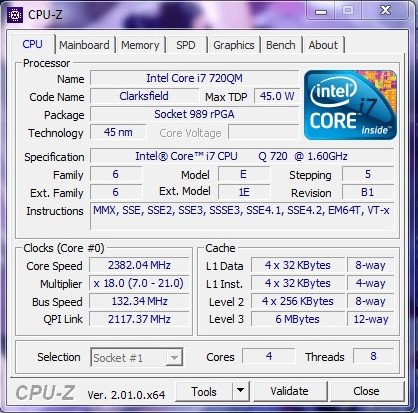SuperPi - 1M score 16sec 52ms with a i7-720QM
Thursday, 01 January 1970 07:00 | Update at null
Media Gallery
Screenshot

Device, Setup, etc



URL
https://hwbot.org/submission/5044484https://www.facebook.com/hakimnu.id/posts/3342371585995481
Information Detail
Hardware: Intel Core i7 720QM
Specs:CPUID : Intel(R) Core(TM) i7 CPU Q 720 @ 1.60GHz
Architecture : x86
Codename : Clarksfield
L3 Cache : 6MB
Clock : 1.60GHz - 2.80GHz
Core/Thread : 4/8
TDP : 45W
Technology : 45nm
Socket : PGA988
IGPU : -
See more specification...
Software: SuperPi - 1M
Score: 16sec 52ms
About: SuperPi - 1MSuperPi - 1M is one of the classic and popular benchmarks used to measure single-thread CPU performance by calculating the number π (pi) to 1 million decimal places. This benchmark has long been a favorite benchmark among tech enthusiasts, overclockers, and hardware testers due to its simplicity, speed, and accuracy in directly assessing processor performance.
In SuperPi 1M testing, only one CPU core is used to complete the calculation as quickly as possible. This makes it ideal for assessing the single-core capability of a CPU, especially in scenarios where single-core performance remains highly relevant, such as in lightweight applications, gaming, or everyday use.
Despite its simplicity, SuperPi 1M is highly sensitive to clock speed, memory latency, and processor architecture efficiency. As a result, this benchmark is often used as a standard in overclocking competitions, as even small differences in system configuration can lead to significantly different execution times.
Features and Advantages:
- Calculates 1 million digits of the number π (pi) with precision.
- Emphasizes the single-thread performance of the processor.
- Runs quickly, ideal for repeated testing.
- Suitable for comparing CPU architecture efficiency.
- Still widely used in the global overclocking community.
Despite the availability of many modern benchmarks, SuperPi 1M remains a significant tool in CPU testing due to its direct representation of basic computational performance. This benchmark is also lightweight and compatible with nearly all Windows versions, making it a practical tool for quick system evaluation.
The Intel Core i7-720QM, launched in Q3 2009, was one of the first mobile quad-core processors to feature Intel's Nehalem microarchitecture, specifically the Clarksfield variant. Targeted at high-performance laptops, such as gaming machines and mobile workstations, the i7-720QM brought 4 physical cores and 8 threads to the mobile platform, thanks to Hyper-Threading Technology providing a significant boost in multi-threaded workloads like video editing, 3D rendering, and other professional-grade applications. The processor runs at a base clock speed of 1.6 GHz, but it can dynamically increase up to 2.8 GHz using Intel Turbo Boost, depending on thermal headroom and power availability.
Manufactured using a 45nm process, the i7-720QM has a TDP of 45W, which is quite high by today's mobile CPU standards. This thermal demand necessitated more robust cooling solutions in laptops that featured the chip. Unlike modern CPUs, the i7-720QM does not come with integrated graphics, which means systems based on this processor require a dedicated GPU often from AMD or NVIDIA for graphics processing and display output. As such, it was typically paired with mid-to-high-end discrete graphics cards in its time, making it a solid choice for gaming and multimedia laptops in the late 2000s and early 2010s.
While the Core i7-720QM was a powerhouse during its release, its performance and efficiency are significantly outpaced by modern CPUs built on smaller nodes and with higher IPC (Instructions Per Clock). Nevertheless, legacy laptops using the i7-720QM can still be viable for basic computing tasks like web browsing, document editing, or watching videos especially if paired with an SSD upgrade and increased RAM. Users running Windows 10 on such systems may experience some limitations, but with proper optimization and lightweight software, the CPU can still deliver a usable experience in non-demanding environments.
Hardware Detail:
Device: HP Pavilion dv3-4054TX
RAM: 4GB DDR3 Single Channel
OS: Windows 7, Windows 10
* Not Avaiable
